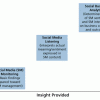Strategic advice to leverage new technologies
Technology is at the heart of nearly every enterprise, enabling new business models and strategies, and serving as the catalyst to industry convergence. Leveraging the right technology can improve business outcomes, providing intelligence and insights that help you make more informed and accurate decisions. From finding patterns in data through data science, to curating relevant insights with data analytics, to the predictive abilities and innumerable applications of AI, to solving challenging business problems with ML, NLP, and knowledge graphs, technology has brought decision-making to a more intelligent level. Keep pace with the technology trends, opportunities, applications, and real-world use cases that will move your organization closer to its transformation and business goals.
Recently Published
Social Business Analytics: Beyond Social Media Listening
Taking advantage of social media insight requires integrating and analyzing social media in conjunction with enterprise data and correlating the findings. This Executive Report examines how social media analytics, when combined with traditional business analytics, can provide rich insights organizations can apply to a range of BI, CRM, marketing, product development, and other data analysis and performance management efforts.
Working Closely with Clients
In an Agile world, we often talk about the importance of involving the client (or key stakeholders) throughout the development cycle. My work experience mainly allowed me to work with two types of clients: internal clients (as part of the IT department in the mid-to-late 1990s) and with product management teams (from 2000 to 2010).
EA is an information and knowledge management discipline. By gathering information about the architecture, its components, and its domains, we come to understand the architectural landscape, and it is through information that we communicate our plans to change and evolve the architecture.
The Internet of Things (IoT) is about more than just sensors and a lot of data and analytics (although these certainly are key components); it also involves the application of new technologies and practices like mobile devices, collaboration, and smart networks that are literally changing how businesses operate and people work. Lately, I've been examining how such technologies are having an impact in manufacturing, engineering, and other industrial environments.
In the early 2000s, I ran a software company called Gray Hill Solutions that specialized in software-for-hire for the government sector, specifically in transportation management and traveler information. Among other projects, we built the original 511.org site for the Metropolitan Transportation Commission in the San Francisco Bay Area. We specialized in rescuing government projects that had spent most of their budget and their time, yet had little to show for the effort.
The bottom line is that we should expect enterprise mobility to continue to grow in importance, spreading to more areas of the enterprise. The main benefits organizations seek from adopting mobile technology are improved worker productivity, improved response to customer needs, and better collaboration and knowledge-sharing among employees.
This year marks the centennial of the start of the First World War. One of the fiercest battles in WWI was the Battle of Passchendaele in Belgium. This manslaughter took place from July-November 1917, with more than 500,000 men lost on both sides for only a few kilometers gained, which were retaken soon afterwards during the German Spring offensive.
Something that differentiates consumer devices from business and enterprise devices is the impact they have on the manner in which people live, their concerns, and how they occupy their time. The ability to immediately monitor a wide variety of characteristics and behaviors on an everyday basis and feed that back to a repository in the cloud inevitably creates an opportunity for control. This control may meet the objectives of the consumer, or it may be targeted to meet the objectives of a vendor. The opportunity for control is likely to become more significant as the IoT develops. Aspects of behavior become a part of a conversation.










